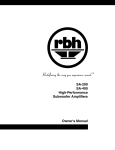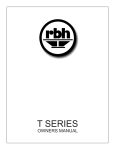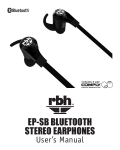Download RBH Sound subwoofer Specifications
Transcript
CA-200 Subwoofer Amplifier Owners Manual Introduction Congratulations on your purchase of an RBH Sound Amplifier! Your amplifier is the result of many years of research and development dedicated to producing powerful, accurate bass in home audio systems. This manual contains operating procedures and specifications. We recommend you thoroughly read through the material contained in this manual before connecting your amplifier. This will ensure you have an understanding of how to setup and operate your amplifier for optimum performance. Important Safety Instructions The lightning flash with the arrowhead symbol within an equilateral triangle, is intended to alert the user to the presence of un-insulated “dangerous voltage” within the product enclosure that may be of sufficient magnitude to constitute a risk of shock to persons. The exclamation point within an equilateral triangle is intended to alert the user to the presence of important operating and maintenance (servicing) instructions in the literature accompanying the product. When using your amplifier, basic safety precautions should always be followed to reduce the risk of fire, electric shock, and injury. 1. Read and understand all instructions in the users manual before operating the amplifier. 2. Retain this user manual for future reference. 3. Follow all warnings and instructions in this manual and any marked on the back of the amplifier. 4. The amplifier should be connected to a power supply compatible with the power consumption requirements, see the specifications section of this manual. 5. If mounting the amplifier on a stand, the wall, or other device only do so as recommended by an RBH Sound authorized technician. 6. Place the amplifier a safe distance from all heat sources such as radiators, stoves, or heaters. 7. Do not operate the amplifier near water—for example, near a bathtub, kitchen sink or in a wet basement; or a swimming pool. 8. Power supply cords should be routed so they are not likely to be walked on or pinched by items placed upon or against them. 9. Any service or repair required must be performed by qualified, RBH Sound authorized technician. Amplifier Controls and Setup WARNING! Make certain the proper power cord is being used and the AC voltage selector switch is set to either 115V or 230V to match the power voltage in your area. This section describes the functions and/or use for each of the amplifier controls. 1. Voltage Selector Switch: Before connecting the amplifier to any power source make sure the AC Voltage Selector is set to either 115V or 230V to match the power voltage in your area. WARNING! If the voltage setting does not match the AC power supplied, damage to the amplifier may result. 1 Amplifier Controls and Setup (continued) IMPORTANT NOTICE REGARDING BASS MANAGEMENT: It is important the signal being sent to the amplifier be a non-boosted or “flat” signal. To be sure of this, check the settings on your receiver or processor to make sure any “bass boost”, “super bass” or “loudness” is set to Off. In most cases for home theater, setting a receiver or processor will determine the crossover frequency through bass management settings. In this configuration, connect the receiver or processor to the LFE Line Level Input. Your amplifier can now reproduce the bass frequencies the way they were originally recorded. Use the amplifier level control and the individual bass management control within the receiver or processor to adjust the amplifiers’ volume if necessary. Once set, the volume controls should not need to be altered as the amplifier’s volume will coincide with the master volume control of your receiver or processor. 2. Volume/Level Control: The volume/level control should be at the minimum setting (all the way counter-clockwise) before plugging the amplifier into an AC wall socket. Once plugged in, turn the level control up one quarter of a turn (9 o’clock position) for an initial setting. The level control may be adjusted while playing to match the level with the rest of the system. 3. 4. 5. 6. 7. 8. IMPORTANT! The volume control should be at the minimum setting (all the way counterclockwise) before plugging the amplifier into an AC wall socket. Crossover Frequency Control: The variable crossover frequency control allows you to set the low-pass crossover point of the amplifier anywhere from 40-180 Hz. Experiment with setting the crossover frequency control at highest setting initially. Increasing the crossover frequency will allow more mid-bass output decreasing the frequency will allow only deeper bass. NOTE: Read the Important Notice above regarding bass management. Auto Signal Tracking: The amplifier uses “smart” signal tracking circuitry. Once the power cord is plugged in and the switch set to auto, the amplifier automatically turns on when a signal is detected at the preamplifier or high level inputs and turns off when no signal has been detected for 15 minutes. Phase Control: This control changes the phase of the amplifier. Changing the phase will change the way the subwoofer and main speakers interact with each other at the crossover frequency. Varying the phase position may result in more or less mid bass depending on the phasing between the main speakers and the subwoofer. Generally, the phase is left at the 0° position. Low-pass Switch: This switch allows the amplifier’s internal crossover to be defeated when using an external crossover, or when the crossover is not needed. This switch should be in the “on” position when the audio signal sent to the amplifier is not from a previously crossed-over source. The switch should be set to “off” when the audio signal sent to the amplifier is coming from a source already using a crossover, such as the subwoofer pre-out from a receiver or pre-amplifier. This will ensure the amplifier is not receiving an audio signal which is double-filtered. NOTE: Read the Important Notice above regarding bass management. Line Output: These RCA terminals are for “daisy chaining” to another subwoofer or amplifier. A full-range signal is sent through these terminals. LFE Line Level Input: Typically this will be the line level input used to connect to most receivers or processors. The LFE input will bypass the amplifier’s crossover control. This input should be used when the input signal is coming from a receiver or processor where the bass management is controlled by the receiver or processor. NOTE: Read the Important Notice above regarding bass management. 2 Amplifier Controls and Setup (continued) 9. High/Speaker Level Input: These binding post terminal connections are for the amplifier/ speaker level input from an amplifier or receiver. IMPORTANT! Use either the Line Input or the High Level Input. DO NOT use them both simultaneously. 10.High Level/Speaker Output: This is a 100 Hz high-passed output for your satellite/main speakers. The crossover limits the low frequencies (below 100 Hz) from going to your satellite/ main speakers. This crossover is active only when using the High Level Input terminals. Connect your main speakers (observing the proper polarity) to these terminals when using the High Level Inputs. 11. Fuse Access: This is the power fuse access. WARNING! In the event the fuse must be replaced, the replacement fuse must match exactly the original fuse value. If the replacement fuse is not of the same value, damage to the amplifier may result. CAUTION! Before replacing the fuse, disconnect the power cord from the power receptacle. CA-200 Subwoofer Amplifier Diagram 3 Troubleshooting Situation: Probable Cause: Solution: No sound from subwoofer. Amplifier is not connected to constant power outlet. Make certain the amplifier is plugged into an unswitched AC power outlet. Amplifier is not receiving an audio signal from receiver or processor. Make certain there is an audio signal from receiver or processor. Amplifier fuse might be blown. Replace fuse (if fuse is not readily accessible, consult your authorized RBH Sound dealer). The + and - polarity of the subwoofer wire might be reversed on the subwoofer. Check the entire system for proper polarity. Experiment with the phase switch settings. Crossover frequency not adjusted correctly. Adjust the crossover frequency by turning the crossover frequency control clockwise until the desired sound is obtained. L/R line level input is connected instead of the LFE line level input. If bass management is enabled on receiver or processor make sure to use the LFE line level input. (See the Amplifier Controls and Setup section of Performance is less than expected. Specifications Model: CA-200 Amplifier Type: Power Output: Distortion (THD): S/N Ratio: Line Level Input Impedance: Speaker Level Input Impedance: Line Level Input Sensitivity: Speaker Level Input Sensitivity: Crossover Slope: Crossover Freq. Range: Auto Turn-on Sensitivity: Frequency Response: Boost: Damping Factor: Cabinet Material and Finish: Dimensions: Discrete Class A/B Subwoofer Amplifier 200 Watts RMS @ 4 Ohms <.04% @ 1 Watt >82dB (without filter) 45 Kohms 200 Ohms 80 mV 2.8V 12dB/Octave 40-180Hz ±dB 2 mV @ 50 Hz 20Hz-40kHz ±3dB (filter off) 4dB @ 25Hz >200 Black Metal Alloy 10” W x 10” H x 5.75” D (482mm W x 101mm H x 355mm D) 14 lbs. (6.35 kg) 1 year Weight: Warranty: 4 Warranty Your RBH Sound subwoofer amplifier is covered by a limited warranty against defects in materials and workmanship for a period of 1 (one) year from the original date of purchase. This warranty is provided by the authorized RBH Sound dealer where the amplifier was purchased. Warranty repair will be performed only when your purchase receipt is presented as proof of ownership and date of purchase. Defective parts will be repaired or replaced without charge by your dealer’s store or the location designated by your dealer authorized to service RBH Sound products. Charges for unauthorized service and transportation cost are not reimbursable under this warranty. This warranty becomes void if the product has been damaged by alteration, misuse or neglect. RBH Sound assumes no liability for property damage or any other incidental or consequential damage whatsoever which may result from the failure of this product. Any and all warranties of merchantability and fitness implied by law are limited to the duration of this express warranty. Some states do not allow limitations on how long an implied warranty lasts, so the above limitations may not apply to you. Some states do not allow the exclusion or limitation of incidental or consequential damages, so the above limitation or exclusion may not apply to you. Redefining The Way You Experience Sound. TM 382 Marshall Way, Layton, Utah • USA • 84041 Toll Free: (800) 543-2205 • Fax: (801) 543-3300 www.rbhsound.com It is RBH Sound policy to continuously incorporate improvements into products; all specifications are subject to change without notice. Copyright © 2012 RBH Sound. All Rights Reserved. 01062012


















